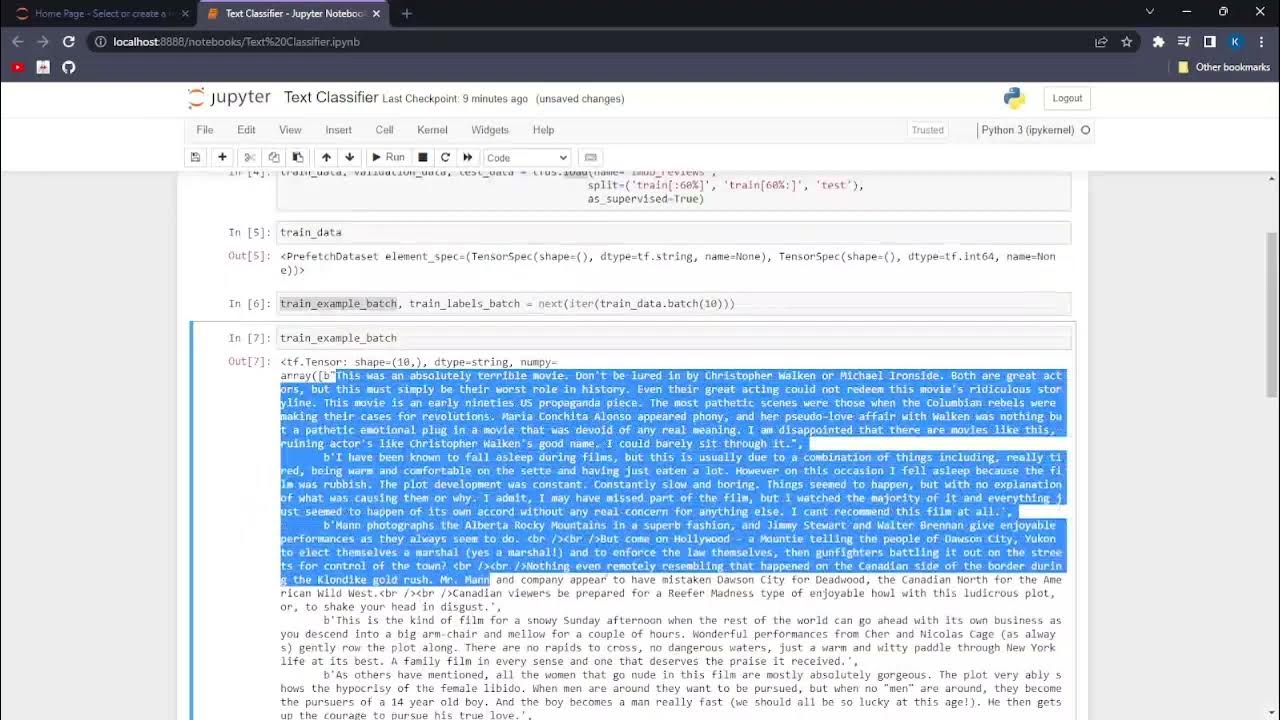Tutorial Klasifikasi Teks dengan Long Short-term Memory (LSTM): Studi Kasus Teks Review E-Commerce
Summary
TLDRThis tutorial demonstrates how to build a text classification model for ecommerce clothing reviews using machine learning techniques. The dataset consists of 23,000 customer reviews, with the goal of classifying reviews based on product categories like pants or shirts. The process includes data preprocessing with tools like Pandas and CountVectorizer, followed by the application of Naive Bayes and LSTM deep learning models. The tutorial covers steps from data cleaning to model evaluation, with a comparison between models based on accuracy and performance metrics. The tutorial also uses Google Colab, Keras, and TensorFlow for training the models.
Takeaways
- 😀 The provided dataset contains over 23,000 customer reviews from an eCommerce platform, including information such as age, title, review text, ratings, and product categories.
- 😀 The goal is to classify reviews into categories like pants, shirts, dresses, based on the content of the review text.
- 😀 Data preprocessing involves removing missing or null values from the dataset using Pandas' `dropna` function.
- 😀 Only the 'review text' and 'category labels' are used for training the model, while other fields are discarded.
- 😀 Text data is transformed into numerical features using `CountVectorizer`, which converts text into token counts for machine learning models.
- 😀 The data is split into training and testing sets, with 80% of the data used for training and the remaining 20% used for testing.
- 😀 Naive Bayes is used initially as the classification model, where the review text is vectorized, and the model is trained on the text data to predict the product category.
- 😀 Evaluation of the model's performance is done through confusion matrices and classification reports to check accuracy and error rates.
- 😀 LSTM (Long Short-Term Memory) is introduced as an alternative model, which is capable of handling sequential data and learning long-term dependencies in text.
- 😀 The LSTM model involves tokenizing the review text, padding sequences, and converting them into word embeddings to feed into the model.
- 😀 After building and training the models, they are evaluated for accuracy, and comparisons are made between Naive Bayes and LSTM performance to select the best model.
Q & A
What is the main objective of the tutorial in the video?
-The main objective of the tutorial is to demonstrate how to classify e-commerce product reviews into categories using machine learning models, specifically focusing on preprocessing text data and training models like Naive Bayes and LSTM.
What dataset is used in the tutorial, and what does it contain?
-The dataset used is the 'Women's Ecommerce Clothing Review' dataset, which contains 23,000 customer reviews. It includes fields like user age, review text, rating, and product category.
What are the key preprocessing steps mentioned in the tutorial?
-Key preprocessing steps include removing null values, extracting relevant features (review text and product category), and transforming the text data into numerical features using CountVectorizer.
What is CountVectorizer, and how is it used in this tutorial?
-CountVectorizer is a technique used to convert text data into a matrix of token counts. In this tutorial, it is used to transform the review text into numerical features that can be fed into machine learning models.
What models are trained in this tutorial, and why were they chosen?
-The tutorial trains two models: Naive Bayes and Long Short-Term Memory (LSTM). Naive Bayes is chosen for its simplicity and effectiveness in text classification, while LSTM is used for its ability to capture sequential dependencies in text data.
What is the purpose of using Google Colab in this tutorial?
-Google Colab is used to run the code because it is a free cloud-based platform that provides the necessary tools and environment for machine learning tasks without needing to install software locally.
What are the advantages of using LSTM for text classification?
-LSTM (Long Short-Term Memory) is ideal for text classification tasks because it can capture long-range dependencies and patterns in sequences of words, making it effective for processing and classifying textual data.
How is model evaluation conducted in the tutorial?
-Model evaluation is conducted using a confusion matrix to measure the performance of the classification models, as well as precision, recall, and F1 score metrics to assess the quality of the predictions.
What are the key differences between Naive Bayes and LSTM for text classification?
-Naive Bayes is a probabilistic model that works well for simpler tasks and small datasets, while LSTM is a deep learning model that excels in handling complex, sequential data such as text, capturing dependencies between words.
What role does padding play in the LSTM model?
-Padding is used in the LSTM model to ensure that all input sequences have the same length. Shorter sequences are padded with zeros to match the length of the longest sequence, ensuring uniform input size for the model.
Outlines

This section is available to paid users only. Please upgrade to access this part.
Upgrade NowMindmap

This section is available to paid users only. Please upgrade to access this part.
Upgrade NowKeywords

This section is available to paid users only. Please upgrade to access this part.
Upgrade NowHighlights

This section is available to paid users only. Please upgrade to access this part.
Upgrade NowTranscripts

This section is available to paid users only. Please upgrade to access this part.
Upgrade NowBrowse More Related Video

Image Classification App | Teachable Machine + TensorFlow Lite

AIP.NP1.Text Classification with TensorFlow

Langsung Paham!!! Berikut Cara Mudah Membuat Sentiment Analysis dengan Python

Prepare your dataset for machine learning (Coding TensorFlow)

PNEUMONIA Detection Using Deep Learning in Tensorflow, Keras & Python | KNOWLEDGE DOCTOR |

Deep Learning Project Environment Setup | Installing Tensorflow Cudatoolkit Nvidia driver in Windows
5.0 / 5 (0 votes)